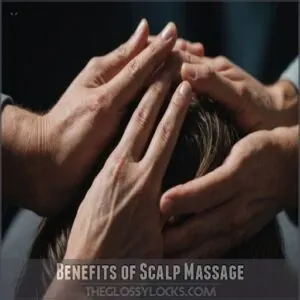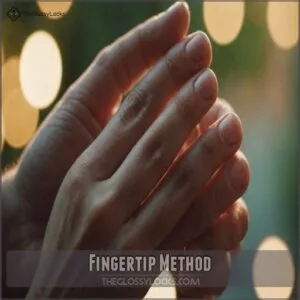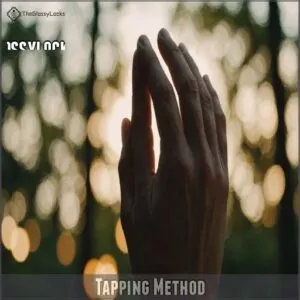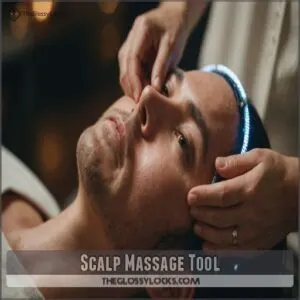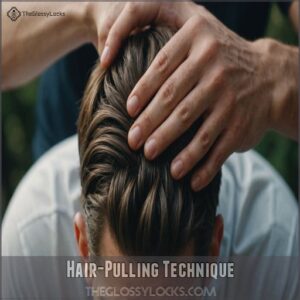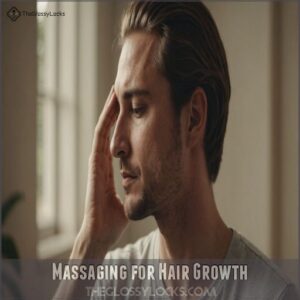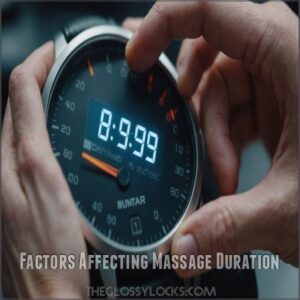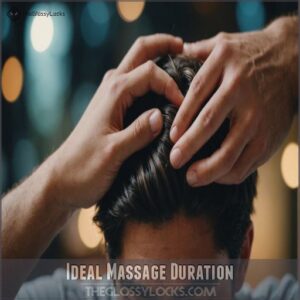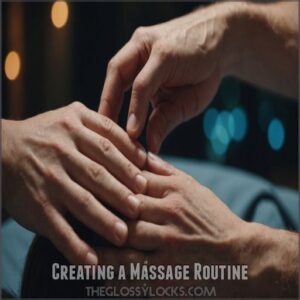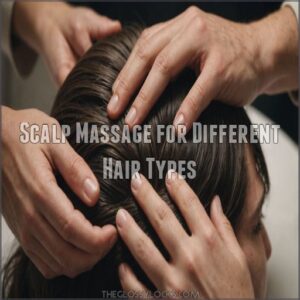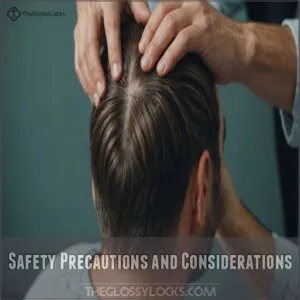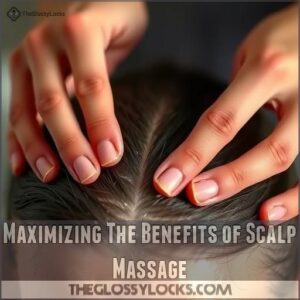This site is supported by our readers. We may earn a commission, at no cost to you, if you purchase through links.
 Wondering how long you should massage your scalp? Aim for 5 to 10 minutes per session, twice a day if possible.
Wondering how long you should massage your scalp? Aim for 5 to 10 minutes per session, twice a day if possible.
This duration balances stimulating hair growth and promoting relaxation without overwhelming your scalp.
Whether you’re tapping out stress or boosting hair volume, consistency trumps marathon sessions. Use gentle pressure—you’re reviving follicles, not kneading dough.
Listen to your scalp’s feedback: if it feels good, you’re on the right track. And remember, patience is key; visible results may take a few weeks to months.
Curious about techniques and enhancing results? There’s plenty more to uncover in scalp care.
Table Of Contents
- Key Takeaways
- Benefits of Scalp Massage
- Choosing The Right Massage Technique
- Massaging for Hair Growth
- Factors Affecting Massage Duration
- Ideal Massage Duration
- Creating a Massage Routine
- Common Mistakes to Avoid
- Scalp Massage for Different Hair Types
- Safety Precautions and Considerations
- Maximizing The Benefits of Scalp Massage
- Frequently Asked Questions (FAQs)
- How long does it take to get a scalp massage?
- Does massaging the head and using an essential oil help with hair growth?
- How often should you massage your scalp?
- How long should a scalp massage last?
- How long should I massage my scalp for hair growth?
- Is it good to massage your head Everyday?
- How long is a good head massage?
- What are the disadvantages of scalp massage?
- Can scalp massage reduce dandruff?
- What are alternative tools for scalp massage?
- Is daily scalp massage beneficial?
- Do scalp massages help with insomnia?
- Are there specific oils for itchy scalp?
- Conclusion
Key Takeaways
- Aim for 5 to 10 minutes per session, twice a day if possible, to balance stimulating hair growth and reducing stress.
- Use gentle pressure during the massage; listen to your scalp’s feedback to avoid irritation.
- Consistency in your massage routine is more beneficial than longer, infrequent sessions.
- Consider adding essential oils like peppermint or rosemary to enhance relaxation and potential hair growth benefits.
Benefits of Scalp Massage
You’ll find that scalp massage offers several potential benefits, including stress reduction and improved hair health.
Studies suggest it may even help alleviate headaches, thanks to increased blood flow and relaxation of tense muscles.
Relaxation and Stress Relief
Beneath the constant chatter of daily stress lies the soothing promise of a scalp massage.
Imagine this: 1. your breath aligning with the gentle rhythm of your fingers, 2. tension headaches dissolve like sugar in warm tea, and 3. relaxation spreads like a cozy blanket.
This simple act is your secret weapon for stress relief, blending mindfulness exercises into a daily relaxation routine.
Hair Growth and Thickness
Curious how regular brushing with a natural boar bristle brush can help stimulate blood circulation in the scalp, increasing sebum production and nourishing follicles. Curious how scalp massages boost hair growth and thickness?
Massaging your scalp can jumpstart blood flow, nourishing hair follicles and paving the way for lush locks.
It’s like giving your scalp a workout without breaking a sweat.
Regular scalp massages, ideally lasting optimal scalp massage duration, can help stimulate dormant hair follicles, reinvigorating them for thicker and stronger strands over time.
By debunking hair growth myths, you enhance scalp health and reinforce hair loss remedies.
Add diet, hair products, and voilà—thicker, healthier hair!
Migraine and Tension Headache Relief
Feeling a migraine coming on? Regular scalp massages can offer tension headache relief by improving blood flow and easing muscle tension.
Use scalp massage tools or your fingertips, applying moderate massage pressure, to target tension headache triggers.
Aim for consistent massage frequency to maximize benefits.
Keep your scalp massage routine easy yet effective, balancing scalp health and headache relief tips.
Choosing The Right Massage Technique
When choosing the right massage technique for your scalp, you should think about various methods like the fingertip, tapping, and hair-pulling techniques.
Each approach offers unique benefits, so understanding which one suits your needs can enhance relaxation and promote hair health.
Fingertip Method
Using the fingertip method, you can transform your hair care routine with simple, effective scalp massage techniques.
Massaging your scalp with gentle fingertip pressure, similar to a technique used when applying Dawn dish soap for hair growth, enhances scalp health and promotes hair growth through gentle fingertip pressure.
DIY tips are easy to follow and adapt with technique variations that suit your needs:
- Use circular motions
- Apply moderate pressure
- Be consistent
- Focus on trouble areas
- Perform daily for best results
Tapping Method
A sprinkle of enthusiasm transforms your scalp routine with the Tapping Method, an energizing technique that enhances hair health.
Use fingertips to gently tap across your scalp, encouraging blood flow and relaxation.
You can also incorporate a scalp massager from a reliable online store like Scalp massager products, which can help increase the effectiveness of this method.
Compare Tapping vs. Circular methods, focusing on your comfort.
Engage consistently for tapping benefits, which can aid hair growth and potentially prevent hair loss over time.
Scalp Massage Tool
Consider using a scalp massage tool; many types exist.
Electric massagers offer deep stimulation, while manual tools provide gentler pressure.
DIY options include using a wide-tooth comb.
Tool benefits include improved scalp blood flow and reduced stress, similar to the effects of yoga asanas for hair growth, which can potentially boost hair growth.
Read tool reviews before purchasing; proper tool usage is key.
Remember, consistent scalp massage is essential for hair growth remedies.
Hair-Pulling Technique
Switch gears from massage tools to your own two hands with the hair-pulling technique.
This method may boost blood flow but practice with care to avoid traction alopecia.
It suits certain hair types better than others, making it important to:
- Assess your hair type.
- Monitor for pain.
- Evaluate the effectiveness.
- Consult a massage therapist if needed.
Massaging for Hair Growth
You’re probably wondering how scalp massage can stimulate hair growth, and the secret is in its ability to boost blood circulation to hair follicles.
By incorporating scalp massages with essential oils or laser photo therapy, you may enhance these potential benefits even further.
How Often to Massage
For best results, integrate scalp massage into your daily routine.
Adjust the massage frequency based on your scalp condition and hair type.
Recognize individual needs; not everyone requires the same approach.
Daily massage may boost hair growth, helping those hair growth tricks work better.
Listen to your body; if you notice discomfort, reassess the frequency.
Combining With Essential Oils
After settling into a regular massage routine, why not enhance the experience with essential oils?
Oil blends like peppermint and rosemary aren’t just aromatic; they’ve been linked to hair growth benefits.
DIY recipes help you match your hair type, especially when using ingredients like coconut oil for hair, but remember safety tips.
Experts suggest patch-testing oils first, guaranteeing a lush scalp massage that’s both relaxing and effective.
Combining With Laser Photo Therapy
Mixing oils into scalp massages sets the stage for laser phototherapy, enhancing your hair growth journey.
Using a laser cap consistently as directed, typically 3-4 sessions per week for 15-30 minutes each, as part of a laser hair growth treatment can further boost results.
Here’s how combining these methods can supercharge results:
- Experience laser therapy benefits through improved circulation and stimulation.
- Pairing treatments boosts hair growth studies success rates.
- Compare costs between standalone and combined treatment plans, optimizing your hair growth plan effortlessly.
Factors Affecting Massage Duration
When deciding how long to massage your scalp, consider your individual tolerance, scalp sensitivity, and the intensity of the massage.
These factors help determine a duration that maximizes benefits without causing discomfort.
Individual Tolerance
So, you’ve mastered the art of massaging for hair growth.
Now, let’s talk about you.
Your personal pain threshold and preferred massage intensity determine your ideal duration.
Listen to your body; stop if it feels uncomfortable.
Some people love long, vigorous sessions; others prefer shorter, gentler ones.
It’s all about finding what works best for your individual needs and preferences.
Remember, consistency matters more than duration.
Scalp Sensitivity
You’ve considered individual tolerance, but let’s not forget scalp sensitivity.
If you feel discomfort or irritation, tweak your massage techniques accordingly.
Sensitive scalp care might involve gentler products and lighter pressure.
Touch those trigger points carefully, or consult hair growth professionals.
While research offers hair growth information, comfort comes first.
Massaging your scalp with rosemary oil for hair growth can help stimulate blood flow and strengthen follicles, which is key to promoting hair growth. Remember, the best hair growth hacks often start with listening to your body.
Massage Intensity
Everyone’s scalp responds differently, especially when considering scalp sensitivity.
The intensity of your massage greatly impacts its duration.
Use gentle versus firm pressure on pressure points to suit your pain tolerance.
Avoid exceeding comfortable limits.
For example, using a massage tool or fingers, adjust pressure and time gradually to enhance benefits without aggravating conditions like androgenetic alopecia or telogen effluvium.
Ideal Massage Duration
Finding the ideal scalp massage duration can enhance your relaxation experience and promote hair health, making it a worthwhile practice.
Whether you’re just starting or an experienced massage enthusiast, adjustments based on your comfort and response can lead to the best results.
Beginner-Friendly Sessions
To kick off your scalp massage journey, start with brief sessions, easing into a relaxing routine.
Try these steps:
- Duration Guidelines: Aim for 5 to 10 minutes, increasing over time.
- Gentle Pressure: Use light, consistent pressure for comfort.
- Massage Frequency: Begin with two to three times a week to align with your hair growth goals and relaxation techniques.
Advanced Massage Techniques
Starting with beginner-friendly sessions, you’re ready to explore advanced techniques like scalp mapping, particularly helpful for conditions like dandruff vs dry scalp, which can be triggered by an overgrowth of Malassezia yeast and excess oil on the scalp.
Focus on pressure points and deep tissue methods, such as acupressure and Gua Sha, to boost effectiveness.
Customizing Your Massage
After mastering advanced techniques, you’re ready to customize your scalp massage.
Find your ideal massage duration by experimenting with massage frequency, pressure level, and oil blends.
It’s your call—create a routine that suits your comfort and targets specific goals.
Whether aiming for enhanced hair growth results or simple relaxation, use this time wisely for maintaining healthy, vibrant hair.
Creating a Massage Routine
To maximize scalp massage benefits, establish a consistent routine, considering factors like frequency and time of day.
Preparing your scalp beforehand, perhaps by gently cleansing it, will enhance the experience and allow for better absorption of any oils you might use.
Frequency and Consistency
Creating a scalp massage routine can bring consistent results. Here’s how:
- Decide on Frequency: Stick to daily or weekly massages.
- Stay Consistent: Regular sessions guarantee long-term benefits, aiding hair growth success.
- Join a Support Group: Engage with the hair growth community for inspiration.
- Track Your Progress: Document your journey to notice your hair growth transformation.
Time of Day
You’ve nailed the frequency; now let’s chat about timing.
Morning massages can jumpstart your day, boosting your blood flow like a coffee without the caffeine.
Evening relaxation, however, helps reduce stress levels and improve sleep quality—a scalp massage could be the best time for winding down.
Use peppermint or rosemary oil for an extra boost for your hair growth future.
Preparing Your Scalp
Before diving into that invigorating scalp massage, take time to prep.
Detangle your hair gently, then consider exfoliating your scalp to remove any buildup, enhancing the massage effect.
Apply essential oils like lavender for relaxation, and use a warm compress to open pores.
This routine boosts hair growth awareness and makes for a smoother, more beneficial massage experience.
Common Mistakes to Avoid
When massaging your scalp, it’s easy to get carried away, but overdoing it can lead to irritated skin or unnecessary friction.
Overdoing it can lead to irritated skin or unnecessary friction.
Make sure you’re not applying too much pressure, as this can harm sensitive scalps and negate the massage’s benefits.
Over-Massaging
A common mistake in scalp massage is overdoing it.
You might think more is better, but too much can lead to scalp irritation, hair breakage, and muscle fatigue.
Remember, moderation is key.
While aiming for improved blood circulation and relaxation, don’t forget your skin’s limits.
Keep sessions short to avoid potential skin damage and enjoy your newfound relaxation.
Using Excessive Pressure
Applying too much pressure during a scalp massage can lead to scalp irritation, pain, and even hair breakage.
You might mean well, but that heavy-handed approach doesn’t help.
Tension headaches and potential blood vessel damage are real risks.
So, think of your scalp like a delicate flower—handle it gently!
Opt for moderate pressure to guarantee a soothing and beneficial massage.
Ignoring Scalp Sensitivity
A tender scalp needs gentle handling.
Ignoring its sensitivity can lead to unpleasant consequences.
When choosing a scalp massager, consider investing in a scalp brush designed for gentle care, such as those available at a Scalp brush marketplace.
Pay attention to these signs:
- Increased redness.
- Persistent itching.
- Sharp, stinging pain.
- Visible inflammation.
Reduce pressure immediately if you experience any of these.
Remember, a relaxing scalp massage shouldn’t cause pain.
Prioritize your scalp’s well-being to prevent scalp irritation and maximize benefits.
Consult a dermatologist for persistent skin conditions.
Scalp Massage for Different Hair Types
To get the most benefits from scalp massage, you’ll want to tailor your approach based on your hair type.
Whether your hair is dry, oily, or a combination, adjusting the duration and technique can enhance both your scalp health and hair quality.
Dry or Damaged Hair
For dry or damaged hair, aim to massage your scalp gently for 5 minutes daily.
This stimulates blood flow and allows nutrients to reach hair roots, promoting health.
Pairing massage with hair oiling or deep conditioning can moisturize and soften your strands.
Regular scalp exfoliation prevents product buildup, while hair masks help repair split ends, ensuring your locks stay resilient.
Oily Hair
Dealing with an oily scalp feels like a juggling act.
Massaging your scalp for just a few minutes can encourage healthy blood flow without over-stimulation.
To avoid weighing your hair down or promoting further oil production, consider oiling your scalp once every two weeks or less.
Try incorporating natural remedies and oil-control products into your routine.
For best results, pair massage with a scalp exfoliation and adjust your hair washing frequency to keep your oil in check.
Combination Hair
Balancing your scalp massage routine for combination hair can be tricky, but it’s manageable.
After handling oily hair, consider focusing on both dry and oily patches.
Use a gentle touch with more targeted product recommendations.
Incorporate oil application techniques to nourish dry areas while still stimulating hair growth.
This way, you maintain healthy, vibrant hair without overwhelming your scalp.
Safety Precautions and Considerations
Before you start massaging your scalp, it’s important to think about any chronic health conditions and existing scalp irritations, which might require a chat with your healthcare provider.
Direct medical advice is essential to avoid potential issues, ensuring that your nourishing routine delivers benefits without unintended surprises.
Chronic Health Conditions
Your doctor’s advice is essential if you have chronic health conditions before diving into scalp massages.
Pre-existing conditions might influence how you should approach these sessions.
Seek medical clearance to avoid any scalp massage risks.
Understanding potential massage contraindications can help you enjoy benefits safely, without health conditions impacting your routine negatively.
Remember, safety first!
Scalp Irritations
Before you start, consider any existing scalp irritations. An itchy scalp or inflammation means you should avoid massage.
Pre-existing conditions like eczema or psoriasis might worsen with massage. Gentle care is key for sensitive scalps.
Always listen to your body; stop if discomfort arises. Remember, natural scalp soothing is important, so prioritize gentle techniques.
If irritation persists, seek advice from a dermatologist. This helps you avoid scalp irritation causes and find the right itchy scalp remedies.
Medical Treatment
When considering scalp massage during medical treatment, keep safety front and center.
Watch out for:
- Scalp Infection Risks: Open wounds or infections can worsen.
- Medical Contraindications: Consult if you’re dealing with a chronic illness.
- Prescription Interactions: Certain meds mightn’t play nice with massages.
Always check with your doctor for personalized advice, ensuring you’re in the clear!
Maximizing The Benefits of Scalp Massage
To maximize the benefits of scalp massage, try combining it with therapies like essential oils or laser phototherapy, which can enhance results.
It’s essential to monitor your progress and adjust your technique accordingly to guarantee the best outcomes for your hair and scalp health.
Combining With Other Therapies
Combining scalp massage with other therapies amplifies its benefits. To further reduce tension bumps and inflammation, incorporating gentle hair care practices, such as using castor oil for scalp relief, can help lock in hydration and promote hair health. Try reflexology techniques to release tension or acupuncture for stress relief. Herbal remedies, like rosemary oil, naturally enhance hair health. Aromatherapy options, such as lavender, add relaxation to each session. Consider meditation practices during massage to center your mind, turning this routine into a holistic wellness ritual.
Monitoring Progress
You’ve tried combining scalp massage with other therapies, but how do you know it’s working?
Progress tracking is your best ally.
Keep a journal of hair growth milestones and take scalp feedback seriously.
Massage consistency is key, so if things slow down, consider a massage adjustment.
It’s like checking your roadmap on a road trip, ensuring you’re headed in the right direction.
Adjusting Your Technique
Tracking your progress is key, but don’t be afraid to tweak your technique!
Experiment with different approaches.
Consider these:
- Varying your finger movement.
- Adjusting pressure on specific massage pressure points.
- Altering hand positioning for best scalp coverage.
- Adapting your technique based on your scalp’s unique texture.
Remember, finding what works best for you is the ultimate goal.
Slight changes can make a big difference.
Frequently Asked Questions (FAQs)
How long does it take to get a scalp massage?
Patience is a virtue.
A typical scalp massage can last between five and twenty minutes, depending on needs.
Shorter sessions may relieve stress, while longer ones can potentially boost blood circulation, promoting hair growth and relaxation.
Does massaging the head and using an essential oil help with hair growth?
Massaging your scalp with essential oils like peppermint or rosemary might help with hair growth.
Studies show increased blood flow and follicle stimulation potentially supporting this.
However, it’s not a standalone solution for significant hair regrowth.
How often should you massage your scalp?
You can enjoy a scalp massage daily, or a few times a week.
Five to ten minutes is usually sufficient, but listen to your body.
More frequent massages mightn’t offer added benefits.
How long should a scalp massage last?
Imagine your scalp as a lush garden.
Spend about 5 to 10 minutes massaging daily or several times a week.
This promotes circulation and relaxation.
Offering hair growth benefits alongside soothing relief from stress and tension.
How long should I massage my scalp for hair growth?
Aim for a scalp massage lasting about 4 to 5 minutes daily.
This duration can improve circulation and potentially promote hair growth.
Be consistent and gentle, and you might notice comforting results over time.
Is it good to massage your head Everyday?
Daily head massages can boost relaxation and potentially aid hair growth.
Research backs stress relief through regular scalp massages, enhancing blood flow, and reducing headaches.
Avoid if you have scalp injuries or conditions, prioritizing safety.
How long is a good head massage?
A good head massage typically lasts 5 to 10 minutes.
This duration helps improve blood circulation, reduce stress, and promote relaxation.
You can massage longer if you prefer, but avoid exerting too much pressure.
What are the disadvantages of scalp massage?
Scalp massage, while generally safe, can irritate sensitive skin or existing scalp conditions.
Overuse may cause hair breakage or follicle damage.
It’s not a substitute for medical treatment—consult a healthcare provider for conditions like lumps or bumps.
Can scalp massage reduce dandruff?
Scalp massage can be a beneficial addition to dandruff treatment.
It has the potential to boost blood flow and exfoliating dead skin, which can help control dandruff.
While not a dandruff cure, regular use of scalp massage can complement treatment, potentially soothing itchiness and improving scalp health.
What are alternative tools for scalp massage?
You can try a scalp massager tool, a partner’s hands, or even a simple comb.
They offer varying pressure and techniques, letting you customize your experience.
Experiment to find what works best for you!
Is daily scalp massage beneficial?
Imagine massaging your scalp as daily magic for stress relief.
While scientific evidence is limited, regular sessions might aid relaxation and improve circulation.
It’s not a cure-all but adds relaxation and potential health benefits.
Do scalp massages help with insomnia?
Scalp massages might help with insomnia by reducing stress and promoting relaxation.
The soothing movements decrease tension, potentially improving sleep quality.
While research is limited, incorporating scalp massages into your bedtime routine could be beneficial for restful nights.
Are there specific oils for itchy scalp?
Try using tea tree, peppermint, or eucalyptus oils for an itchy scalp.
These oils can soothe irritation, reduce flakiness, and help maintain scalp health.
When choosing essential oils for dry skin, consider combining them with carrier oils like jojoba or sweet almond, as recommended for their moisturizing properties. Just mix them with a carrier oil before applying to avoid skin irritation.
Conclusion
Think of your scalp massage like a gentle journey to a healthier you, where patience and consistency are key. Whether you’re aiming for relaxation or hair growth, knowing how long you should massage your scalp is important.
Stick to 5 to 10 minutes per session for balanced benefits.
Listen to your scalp, adjust your technique, and enjoy the process.
Over time, you’ll likely notice rewarding changes—not overnight, but like all good things, it’ll be worthwhile.

